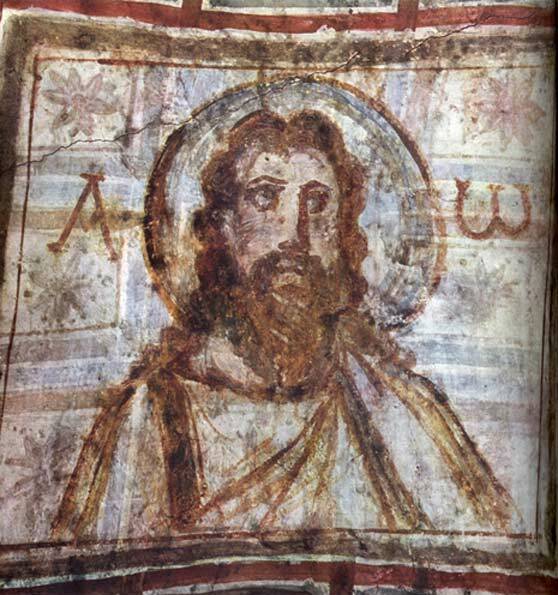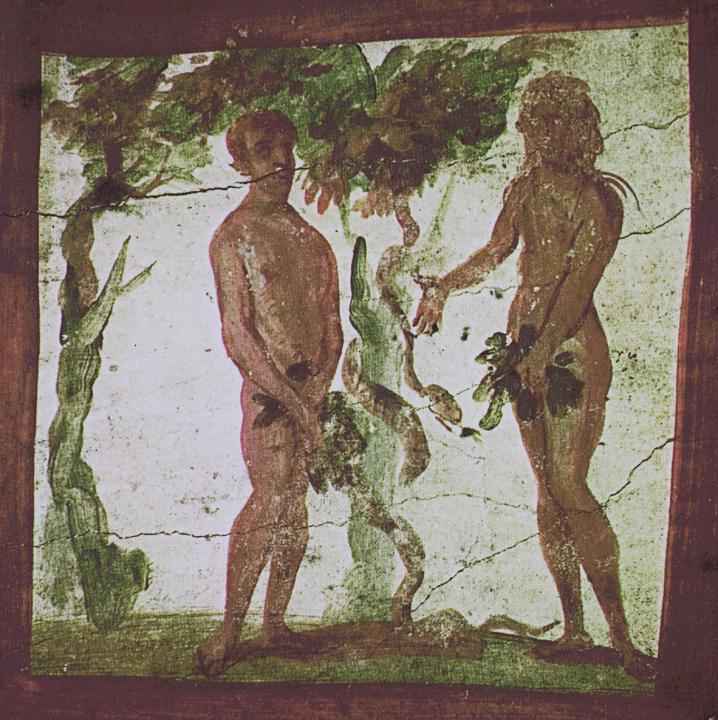102: Origin of Christian Art
There has been much discussion of late years as to the influences which were predominant in the development of early Christian art. Professor Wickhoff in a striking essay (Roman Art, tr., 1900) has contended that in the first century after Christ a distinctively Roman style was evolved both in painting and sculpture, the salient features of which he characterizes as impressionist or "illusionist". He marks several stages in the growth of this style, and claims for it especially the creation of what he calls the continuous method of composition, i.e. a method by which several successive stages of the same history are depicted together in a single painting. Further, he contends that this Roman style was adopted by the first Christian artists and that, though obscured and weakened, it persuaded the Roman world and maintained its identity throughout the Middle Ages until eventually it quickened again into fuller life under the stimulus of the Renaissance.
This view, an exaggeration of the Romanist hypothesis which long held the field has been severely criticized by many competent authorities and notably by Strzygowski ("Orient oder Rom", 1901, and "Kleinasien", 1903), who attributes the predominantly influence in the development of Christian art to the recrudescence of purely Oriental feeling. This, as he maintained, had always survived at Byzantium, Antioch and Alexandria, and it became operative once more when the Graeco-Roman artistic tradition at Rome had exhausted itself after the effort of a few centuries. Though Strzygowski may go too far when he claims that even the art of the Romanized provinces like Gaul came from the East direct and not through Rome, it seems highly probable that his contention is in substance accurate enough.
To Rome no doubt must be assigned the prevalence of the basilica type of church and the first effective conception of the possibilities of stone vaulting. But the transference of the seat of government by Honorius in 404 from Rome to Ravenna and the confusion that arose in the Western Roman Empire, had far-reaching consequences upon the development of art. If Rome was at all times the seat of the papacy, the vicars of Christ had not at this early date acquired any preponderating influence in the social and civil affairs of the Western world, while more than a hundred years after this beginning with the seventh century, no less than thirteen pontiffs who occupied in succession the chair of St. Peter were of Greek or Syrian origin. But what is perhaps most important of all, the Latin stock who occupied what was once the great city, but what now became only a provincial town, were morally and intellectually effete.

The motive power for a new development was to come from outside. The impetuous energy of the Teutonic tribes of the North was full of latent possibilities for the arts of peace, when that energy was once diverted from the strenuous occupations of a time of war. Once again "Graecia capta ferum victorem cepit", but it was Greece enriched this time with the inheritance of Antioch, Ephesus, and Alexandria, while the culture that now travelled west. and north found ultimately a more responsive soil than it had ever met with in Latium. In its adoption by Goths, Franks, and Saxons the art of Byzantium lost its rigidity, and something of its formalism. It was a living germ which soon developed an independent growth, and long before the Renaissance once more directed the minds of men to classic models, not only architecture and sculpture, but the arts of the painter, the iron-worker, the goldsmith. and the glass founder were full of vigorous life and promise throughout all Western Europe.
The earliest specimens of decorations employed for a Christian purpose are found in the Roman catacombs. In the most ancient examples of all the private chambers used for Christian interment in the first and second centuries, there is decoration indeed, but it is only in a negative sense that it can be called Christian art, for while the abundant frescoes seen in the cemetery of Domitilla and notably in the cubiculum of Ampliatus exclude such pagan elements as would be unseemly, the character of the painting is in every respect the counterpart of the ornamentation of the contemporary private houses buried at Pompeii. There is nothing distinctively Christian. Perhaps the frequent recurrence of the vine as a principal element in the scheme of decoration may have been meant to suggest the thought of Christ, the true vine, but even this is doubtful. Symbolism occurs early, but it can only be recognized with confidence in the more public cemeteries of the second century, e.g. that of St. Callistus; here, under the influence of the "Discipline of the Secret", it is hardly wrong to recognize the true beginnings of a distinctively Christian art.
No doubt this art in a most marked degree was imitative of the more decent forms of pagan decoration familiar at the period. It seems constantly to be forgotten by those who discuss this subject that it was the deliberate object of the early Christians, during the ages of suspicion and persecution to exclude from their places of sepulture all that would by its conspicuousness or strangeness attract the notice of the casual pagan intruder. No wonder that the theme of the Good Shepherd in introduced again and again in the fresco decorations of the early catacombs. This is no indication as rationalist critics have sometimes pretended, of the survival of an idolatrous mythology, but the very likeness of the beardless Good Shepherd to the type of the pagan Hermes Kriophorus — a likeness, however, which is never so exact as to lead to real confusion — constituted its recommendation to those who wished to hide their distinctive practices from the prying eyes of the people around them.

In the same way the Orante, or praying figure, symbolical of the Church or the individual soul, bore a general resemblance to the statues of Pietas, familiar enough to the ordinary Roman citizen, while the dove, which was to the Christian eloquent of the grace of the Holy Spirit, would not have been distinguished by his pagan neighbour from the birds consecrated to Venus. The deeper mysteries of the Eucharist and of the other sacraments were still more artfully veiled in the frescoes of those early centuries. No doubt the fish was an object familiar enough in all kinds of pagan decoration, but that very fact rendered it most suitable for the purpose of the Christian when he wished to symbolize the marvellous workings of Christ (Iesous Christos Theou Yios Soter = ICHTHYS, the fish) in the waters of baptism.
What again was more common in decoration than some form of banqueting scene — a theme also often utilized by the worshippers of Mithra-- but these feasts depicted upon the walls of a sepulchral chamber had a far other and deeper significance for the Christian, who by some minute sign, the little cross, it may be, impressed upon the loaves, or the fishes which decked the frugal board, was quick to discern the reference to the life-giving mystery of the Blessed Eucharist. There are also human figures and Biblical scenes, especially those connected with the liturgy for the departed — for example the miraculous restorations of Jonah and Daniel and Lazarus — and in one or two isolated instances we may perhaps recognize a presentment of the Madonna, but the reference is always cryptic and only interpretable by the initiated. It was under these circumstances that the instinct of religious symbolism was developed when the art of the Church was yet in its infancy but the tradition thus created has never departed from true religious art throughout the ages.

With the triumph of the Church under Constantine the necessity for the sedulous hiding of the mysteries of the Faith in large measure disappeared. From A.D. 313 to the end of the fifth century was a period of transformation and development in Christian art, and it may be conspicuously recognized upon the walls of the Roman catacombs. Biblical scenes abound, and the figure of Christ, no longer so frequently as the beardless Good Shepherd, but crowned with a nimbus and sitting or standing in the attitude of authority, is fearlessly introduced. The nimbus is also extended to others beside Christ, for example to Our Lady and some of the saints. Sculpture again, though in the catacombs the traces it has left are relatively few now for the first time becomes the helpmate of painting in the service of the Church. This is the age of the great Christian sarcophagi so wonderfully decorated with the figures of Christ and His Apostles and with biblical scenes still full of symbolic meaning.
The old ways of the period of persecution had, it is plain, become not only familiar but dear to the body of the faithful. The allegorical method of representing the mysteries of the Faith did not disappear at once. But though with the triumph of Constantine the outline of the "chrisme" (chi-rho), or the Greek monogram of Christ, was universally held in honour and introduced into all Christian monuments and even into the coinage, the crucifix as a Christian emblem was as yet practically unknown. For more than a century the memory of the Sacrifice of Calvary was recalled to the minds of the faithful only by some such device as that of a plain cross impressed with the figure of a lamb. The first representations of the figure of the Saviour nailed upon the Rood, as we see it upon the carved doors of Sta. Sabina in Rome and in the British Museum ivory, belong probably to the fifth century, but for a long period after that this subject is very rarely found, and its occurrence in frescoes or mosaics is hardly recorded anywhere before the time of Justinian (527 - 565).